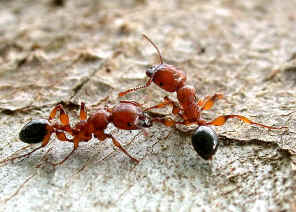Subfamily Myrmicinae - Myrmicine ants

- Myrmicinae is the largest ants subfamily in Australia. They are from small to medium in size, with the smallest about 1 mm long and the largest up to 10 mm.


- Myrmicine Ants usually have short triangular jaws and small eyes. The mesosoma is attached to the gaster by two distinct segments. There is sting at the tip of their gaster.
- Black Valentine Ant



- Crematogaster laeviceps, body length 5mm
- Crematogaster is a common genera. Some species are black and some are brown with black abdomen. Those ants have the heart-shaped gaster so their name Valentine Ants. They are usually found on plants. Please also check this page for more pictures and information.
- Bicoloured Pennant Ant


- Tetramorium bicarinatum, body length 5mm
- We sometimes found those ants nested in our backyards. Please check this page for more information.
- Muscleman Tree-ant



- Podomyrma gratiosa, body length 10 to 12 mm
- They are quite a large ants. The ants are brown in colour with black abdomen. Their legs are strong. Their nest is in a live tree trunk. We recorded how those ants caught a bug. Details please click on here.
- Yellow Shield Ant


- Meranoplus sp., body length 4mm
- We found those ants wandering on leaves. The ants have the dark grey body with golden yellow abdomen. Please also check this page for more information.
- Brown Shield Ant


- Meranoplus sp., body length 5mm
- Pictures taken in Karawatha Forest, August 2007. Please also check this page for more information.
- Reference:
- 1. Insects of Australia and New Zealand - R. J. Tillyard, Angus & Robertson, Ltd, Sydney, 1926, p288.
- 2. Podomyrma - myrmecos.net, 2005.
- 3. Tetramorium - myrmecos.net, 2005.
- 4. Crematogaster - myrmecos.net, 2005.
- 5. Australian Ants: Their Biology and Identification - S Shattuck, Natalie J Barnett, CSIRO, 1999, p208.
This page contains pictures and information about Myrmicine ants that we found in the Brisbane area, Queensland, Australia.
